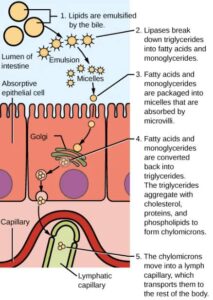Back to: ZOOLOGY 400 Level
Welcome to class!
Hello, my ever-curious champion! I’m so glad to have you here again. Today, we’re going to talk about something that happens right after digestion — Absorptive Surfaces and Nutrient Uptake. You know when you eat jollof rice or a bowl of yam porridge, your body needs to do more than just break it down. It must absorb all the good stuff — like carbohydrates, proteins, vitamins — so that your body can use them. Let’s see how that happens!
Absorptive Surfaces And Nutrient Uptake
What Are Absorptive Surfaces?
Absorptive surfaces are the special parts of your digestive system that soak up nutrients from your food into the bloodstream. The main place where this magic happens is in the small intestine — specifically in its inner lining.
Key Features of Absorptive Surfaces
The small intestine has been designed in a way that makes absorption super effective:

Villi and Microvilli: These are tiny finger-like projections lining the inside of the small intestine. Villi increase the surface area so that more nutrients can be absorbed quickly. On each villus are even smaller projections called microvilli, forming what we call the brush border.
Example: Imagine trying to dry your body with a towel. A fluffy towel with lots of loops (like villi) will absorb more water than a flat cloth. That’s how villi help the small intestine “soak up” more nutrients!
Thin Walls: The walls of the villi are very thin, so nutrients can pass through easily into the blood capillaries or lymph vessels.
Rich Blood Supply: Capillaries and lymph vessels in each villus quickly carry absorbed nutrients like glucose, amino acids, and fatty acids to different parts of the body.
Types of Nutrient Uptake
Carbohydrates are broken down into glucose and absorbed into the blood through the capillaries.
Proteins are broken into amino acids and also absorbed into the blood.
Fats (lipids) are broken into fatty acids and glycerol, which are absorbed into lymph vessels called lacteals inside each villus.
Vitamins and minerals are absorbed depending on whether they are water- or fat-soluble.

Example: When you drink orange juice, the vitamin C (a water-soluble vitamin) is absorbed straight into your bloodstream through the villi.
Why This Process is Important
Without efficient nutrient uptake, even if you eat the best food, your body won’t benefit from it. Absorptive surfaces make sure every bit of nourishment is captured and delivered to your organs, tissues, and cells.
Summary
- Absorptive surfaces allow nutrients from digested food to enter the bloodstream.
- The small intestine, with villi and microvilli, is the main site of absorption.
- Villi increase surface area and have thin walls and rich blood supply.
- Nutrients like glucose, amino acids, and fatty acids are absorbed into blood or lymph vessels.
- Efficient absorption is essential for growth, energy, and overall body function.
Evaluation
- What are villi, and what is their role in nutrient uptake?
- How do the structure and function of the small intestine help in absorption?
- Which type of nutrient is absorbed into the lymph vessels?
- What happens if the absorptive surfaces in the small intestine are damaged?
- Why is it important to have a large surface area in the small intestine?
You are doing so well, and I’m so proud of you! You’ve just learned how your body captures every drop of goodness from the food you eat. Keep going — your mind is sharp, your effort is strong, and your future is bright. Afrilearn is right here with you all the way. Let’s keep learning, growing, and shining together!
